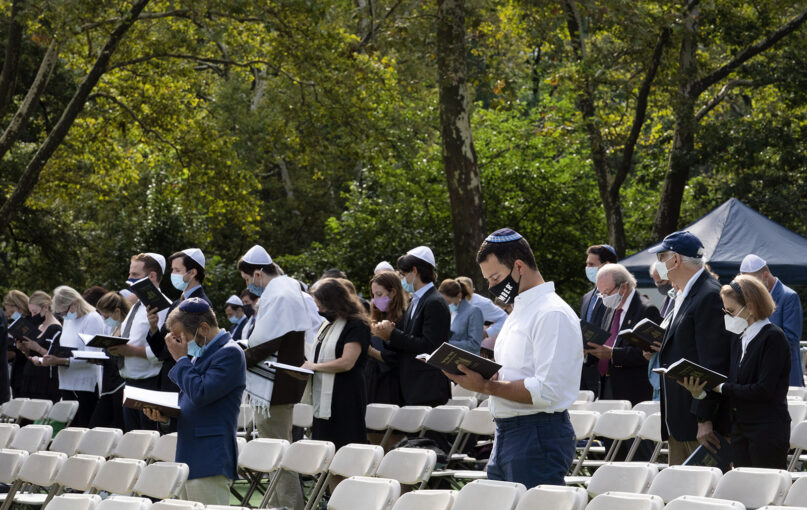(RNS) — At around 8 p.m. this past Friday evening, an odd feeling of confusion overtook me.
There I was, at my synagogue, Temple Israel in West Palm Beach, Florida. I was sitting at a table, talking to someone and eating. “What is this thing we are doing?” I asked myself. “What do you call this?”
Ah, yes. I suddenly remembered. It is called an oneg Shabbat — that thing after the Shabbat eve service where people get together to shmooze, eat and socialize.
I had forgotten what it was like.
So, too, I had almost forgotten about what happened before that: more than a hundred worshippers in our sanctuary. Yes, masked. Yes, socially distanced.
We had been open for months. Yes, we had great attendance for the High Holy Days. But, those numbers were nothing like this past Friday evening.
There they were. They were singing with our soloist, Peri Smilow — whom they had never met or heard or sung with in person, who usually does services with us remotely on Zoom from her home in New Jersey. Her voice and guitar stunningly merged with the artistry of our pianist, David Block. (Frankly, she was the draw!)
People. Singing. In our sanctuary.
OMG. Literally — OMG.
Which brings me to David Suissa’s recent article, “A Problem Too Painful To Look At,” in the Jewish Journal. David has named an anxiety many Jewish leaders are experiencing:
On one hand, there’s real excitement about how digital technology has kept so many communities connected and has expanded global reach.
But beneath that excitement, I noticed a simmering anxiety that has become difficult to confront: How permanent is the lingering reluctance to enter enclosed spaces like synagogues? Has the amazing convenience of online technology led to new habits that will be hard to shake?
The killer quote:
The synagogue world is now faced with two extremes — the miracle of digital versus the trauma of dwindling attendance. They both feed off each other, and together represent a threat to the future viability of many synagogues, especially those that were already struggling.
David is not alone in his worries. It is an interfaith activity. There have been several oft-tweeted, oft-Facebook-posted articles from the Christian world asking the same questions.
My “favorite” is “My Church Doesn’t Know What to Do Anymore,” by Elizabeth Felicetti, in The Atlantic.
I don’t know how to make this work. After a year of trying to assure people that we were still the church even when we weren’t in the same room, I don’t know how to convince them now of the importance of gathering in person. I know that if they are watching from home, fancier churches all over the country offer much slicker streamed services than our suburban church with its secondhand camera and duct-taped tripod. And no matter what we do, it isn’t going to work for someone. A few families have started attending larger churches with more — or less — restrictive masking policies. I also know that kids’ sports, held outdoors, have fewer restrictions, and that returning to a church habit after 20 months away gets harder with each passing Sunday.
This is what I think is going on.
Many of us long to be back together with each other in worship.
But, for many worshippers, what started as a necessity — watching services online — has now become a preference.
Why get dressed and drive to a place of worship, when you can sit there in your sweats and watch it from the comfort of your home? Especially if you can watch a slick, technologically adept entertaining service from Somewhere.
In short, many of us have become liturgical couch potatoes.
What we do not know yet is simply this: When they can come back to live, in-person worship, will they?
Because the pandemic is not the only trend responsible for somewhat empty pews. America has been increasingly secularizing — to an extent, America has, in the space of several years, religiously speaking, become Europe.
So, you have a perfect religious storm.
- COVID told people: You can’t attend worship services in person.
- The zeitgeist told people: You didn’t want to go to services, anyway.
Are we about to have a religious reboot?
Perhaps. But, increasingly we sense it will not be the way it was B.C. — Before COVID. Not only because of COVID, but because the spirit of the times demands something, well, different.
More than 50 years ago, the late Leonard Cohen (whose fifth yahrzeit we recently observed), put it this way, diagnosing the spiritual condition of the Jews of Montreal:
The community was like an old lady whose canary has escaped in a storm, but who continues to furnish the cage with food and water in the convinced hope that the canary will come back. There are those who would teach that this optimism is religion.
The Jews are the canary that has escaped in a storm — of COVID and apathy.
If we want people to come back, then it will need to be for something more filling than that old bird seed and water.






